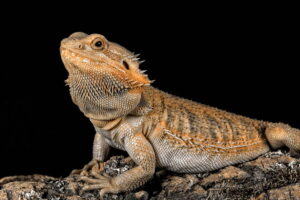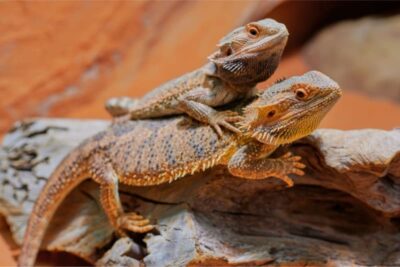Establishing a proper feeding schedule is crucial for the health and well-being of your bearded dragon. A well-designed bearded dragon feeding schedule ensures they receive the essential nutrients they need while promoting healthy growth and development.
A bearded dragon feeding schedule refers to a plan or routine that outlines when and what your bearded dragon should eat. By following a structured feeding schedule, you can ensure that your pet receives the right balance of nutrients for their growth, development, and overall well-being.
This schedule typically includes feeding live insects, vegetables, and occasional treats such as fruits or commercial treats, with adjustments made based on the dragon’s age and size. A feeding schedule also helps prevent overfeeding or underfeeding, ensures variety in their diet, and promotes healthy eating habits.
Importance of proper feeding for bearded dragons

Proper feeding is of paramount importance for the health and well-being of bearded dragons due to several key reasons:
- Nutritional Balance: Bearded dragons require a balanced diet to thrive. Providing a variety of foods ensures they receive essential nutrients such as protein, vitamins, minerals, and fiber necessary for growth, development, and overall health.
- Growth and Development: Adequate nutrition supports proper growth and development in bearded dragons, especially during their juvenile stages. Essential nutrients like protein and calcium are crucial for bone and muscle development, while vitamins support various physiological processes.
- Digestive Health: Feeding a diet rich in fiber from vegetables and greens promotes healthy digestion and helps prevent issues like constipation or impaction. Additionally, providing live insects stimulates natural foraging behaviors and encourages physical activity, which aids in digestion.
- Prevention of Nutritional Deficiencies: Proper feeding helps prevent nutritional deficiencies that can lead to health problems such as metabolic bone disease (MBD). Calcium, vitamin D3, and phosphorus balance are particularly important for skeletal health and metabolic function.
- Hydration: Certain foods, such as fruits and vegetables with high water content, contribute to hydration in bearded dragons. Proper hydration is essential for overall health, skin hydration, and proper organ function.
- Weight Management: Monitoring feeding amounts and frequencies helps prevent obesity and weight-related health issues. Overfeeding can lead to obesity and associated health problems, while underfeeding can result in malnutrition and stunted growth.
- Behavioral Health: Providing a varied diet and opportunities for natural foraging behaviors promotes mental stimulation and overall behavioral health in bearded dragons. This can reduce stress and boredom commonly associated with captivity.
Overall, proper feeding is critical for meeting the nutritional needs of bearded dragons, supporting their growth and development, and promoting long-term health and vitality. A well-rounded diet, tailored to their age, size, and individual requirements, is essential for their overall well-being.
Regular monitoring, adjustments to feeding schedules as needed, and consultation with a reptile veterinarian can help ensure optimal feeding practices for your pet bearded dragon.
Feeding Schedule for Bearded Dragons
A feeding schedule for bearded dragons should be tailored to their age, size, and individual needs. Here’s a general guideline for a feeding schedule:
Juveniles (0-6 months old):
- Offer live insects (appropriately sized) 2-3 times per day, allowing them to eat as much as they want in a 10-15 minute period.
- Provide a variety of vegetables and greens daily, chopped into small pieces.
- Offer occasional treats such as fruits or commercial bearded dragon treats once or twice a week.
- Dust insects with calcium powder at least 5 times per week and with a multivitamin supplement 2-3 times per week.
Subadults (6-12 months old):
- Feed live insects once or twice a day.
- Continue offering a variety of vegetables and greens daily.
- Maintain the same supplementation schedule as for juveniles.
Adults (12+ months old):
- Feed live insects every other day or a few times per week.
- Vegetables and greens should still be offered daily.
- Reduce supplementation to calcium powder 2-3 times per week and multivitamin supplement once a week.
Water:
- Provide fresh, clean water in a shallow dish daily. Some bearded dragons prefer to drink from moving water, so misting their enclosure or providing a drip system can encourage hydration.
It’s essential to adjust the feeding schedule based on your individual bearded dragon’s appetite, activity level, and overall health. Regularly monitor their body condition to ensure they’re maintaining a healthy weight. Consulting with a reptile veterinarian can help tailor a feeding schedule specific to your pet’s needs.
Types of food to offer

When feeding your bearded dragon, it’s essential to offer a variety of foods to ensure they receive a balanced diet. Here are the main types of food to include in their diet:
- Live Insects: Live insects are a crucial part of a bearded dragon’s diet, especially for juveniles and subadults. Offer a variety of appropriately sized insects, such as crickets, dubia roaches, mealworms, superworms, hornworms, and silkworms. Gut-load insects with nutritious foods before feeding them to your dragon.
- Leafy Greens: Leafy greens should make up a significant portion of your bearded dragon’s diet. Offer a variety of greens, such as collard greens, mustard greens, dandelion greens, kale, bok choy, and turnip greens. These provide essential vitamins, minerals, and fiber.
- Vegetables: Along with leafy greens, offer a variety of vegetables to provide additional nutrients and variety. Suitable options include squash, bell peppers, carrots, zucchini, sweet potatoes, snap peas, and green beans. Chop or grate vegetables into small pieces for easy consumption.
- Fruits: Fruits can be offered as occasional treats due to their higher sugar content. Choose fruits such as berries, apples, mangoes, papayas, and melons. Remove any seeds or pits before feeding.
- Commercial Diets: Commercially available bearded dragon diets, such as pellets or powders, can be convenient and provide a balanced source of nutrition. Look for high-quality products formulated specifically for bearded dragons.
- Occasional Treats: Offer occasional treats to add variety to your bearded dragon’s diet. These can include cooked eggs (without seasoning), pinky mice (for adult dragons), and commercial treats formulated for reptiles.
- Supplements: Dust live insects with calcium powder before feeding them to your bearded dragon to ensure they receive enough calcium for bone health. Additionally, offer a multivitamin supplement a few times a week to cover any potential nutritional gaps.
It’s essential to offer a balanced mix of these foods to meet your bearded dragon’s nutritional needs. Experiment with different foods and observe their preferences and eating habits to ensure they receive a varied and nutritious diet.
Feeding Techniques and Tips

Feeding your bearded dragon involves more than just offering food; it requires attention to detail and consideration of their dietary needs. Here are some feeding techniques and tips to ensure your bearded dragon stays healthy and happy:
- Variety is Key: Offer a diverse range of foods to provide a balanced diet. Include live insects, such as crickets, dubia roaches, mealworms, and silkworms, along with a variety of vegetables and occasional fruits. This ensures they receive a wide array of nutrients.
- Appropriate Insect Size: Choose live insects that are appropriate for your bearded dragon’s size. Insects should be smaller than the space between their eyes to prevent choking or digestive issues.
- Gut Loading Insects: Gut-loading insects involves feeding them a nutritious diet before offering them to your bearded dragon. This enhances the nutritional value of the insects and benefits your pet.
- Supplementation: Dust live insects with calcium powder before feeding to ensure your bearded dragon receives enough calcium for bone health. Additionally, offer a multivitamin supplement a few times a week to cover any potential nutritional gaps.
- Chop or Grate Vegetables: Bearded dragons may prefer smaller pieces of vegetables and greens. Chop or grate them into small, manageable pieces to encourage consumption.
- Hydration: Ensure your bearded dragon stays hydrated by providing a shallow dish of fresh water daily. Some dragons may prefer to drink from moving water sources, so misting their enclosure or providing a drip system can help encourage hydration.
- Feeding Time: Feed your bearded dragon during the day when they are most active. Allow them to feed for 10-15 minutes, then remove any uneaten food to prevent spoilage and maintain cleanliness in their enclosure.
- Monitor Weight and Body Condition: Regularly monitor your bearded dragon’s weight and body condition to ensure they’re maintaining a healthy weight. Adjust their feeding schedule and portion sizes accordingly.
- Observe Eating Habits: Pay attention to your bearded dragon’s eating habits and appetite. Changes in appetite or behavior may indicate underlying health issues that require attention.
- Consult with a Veterinarian: If you’re unsure about your bearded dragon’s diet or have concerns about their health, consult with a reptile veterinarian. They can provide personalized advice and guidance based on your pet’s specific needs.
By implementing these feeding techniques and tips, you can ensure your bearded dragon receives a nutritious and balanced diet that supports their overall health and well-being.
Recognizing signs of overfeeding or underfeeding
Recognizing signs of overfeeding or underfeeding in your bearded dragon is crucial for maintaining their health and well-being. Here are some indicators to look out for:
Signs of Overfeeding:
- Obesity: Bearded dragons that are overfed may become overweight or obese. Look for signs of excessive fat deposits, particularly around the abdomen and tail base.
- Difficulty Moving: Overweight bearded dragons may have difficulty moving or become lethargic due to the excess weight.
- Regurgitation: Overfeeding can lead to regurgitation or vomiting in bearded dragons. If your dragon is regurgitating food frequently, it may be a sign that they are being fed too much.
- Fatty Liver Disease: Excessive fat intake from overfeeding can lead to fatty liver disease, a serious condition that affects the liver function. Symptoms include lethargy, loss of appetite, and jaundice (yellowing of the skin and eyes).
- Constipation or Impaction: Overfeeding can result in constipation or impaction, where food becomes stuck in the digestive tract. Signs include straining to defecate, lack of bowel movements, and abdominal discomfort.
Signs of Underfeeding:
- Weight Loss: Bearded dragons that are underfed may experience weight loss or appear thin and emaciated.
- Lethargy: Lack of energy or lethargy can indicate underfeeding in bearded dragons. They may be less active and spend more time basking or hiding.
- Sunken Eyes: Underfed bearded dragons may have sunken or dull-looking eyes, indicating dehydration or malnutrition.
- Loss of Appetite: A sudden decrease in appetite or refusal to eat can be a sign of underfeeding or an underlying health issue.
- Decreased Growth: Juvenile bearded dragons may exhibit slower growth rates if they are not receiving enough food and nutrients.
If you suspect that your bearded dragon is being overfed or underfed, it’s essential to adjust their feeding regimen accordingly. Consult with a reptile veterinarian for guidance on proper feeding practices and to address any underlying health concerns. Regular monitoring of your dragon’s weight, body condition, and behavior can help prevent overfeeding or underfeeding and ensure they maintain optimal health.
Conclusion
Establishing a structured bearded dragon feeding schedule is essential for ensuring they receive the proper nutrition for their health and well-being. By incorporating a variety of live insects, vegetables, fruits, and occasional treats, you can provide a balanced diet that meets their dietary requirements at different life stages.
Monitoring their weight, body condition, and behavior allows for adjustments to the feeding regimen as needed, promoting optimal health and longevity for your pet.

